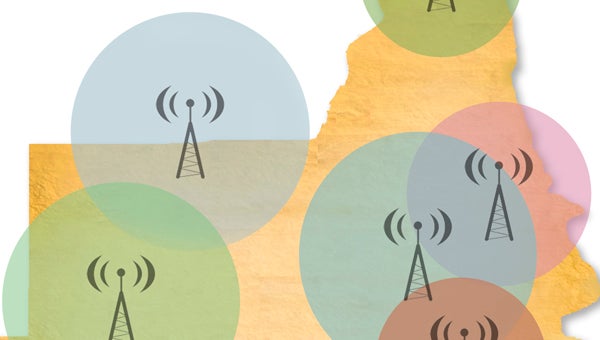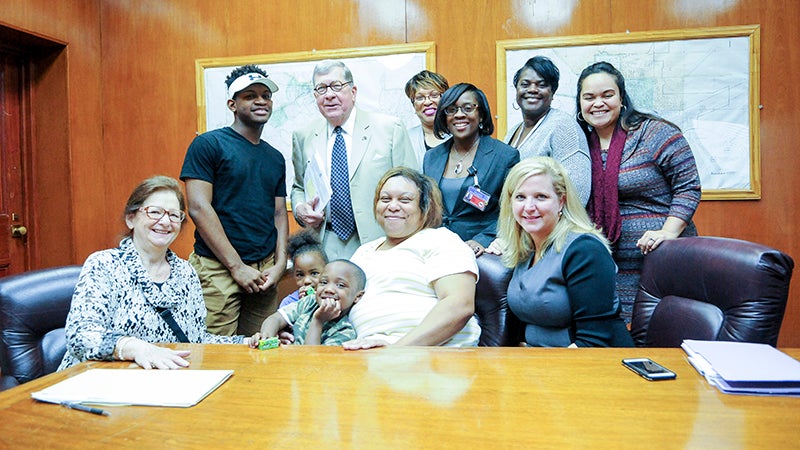Area’s cellphone coverage is lacking
Published 12:14 am Sunday, July 17, 2011

The sweeping landscape of the Black Belt is one of the area’s most alluring features, but it has proven to be a problem in providing full, quality cellular coverage. -- Graphic by Tim Reeves
By Alison McFerrin
The Selma Times-Journal
For many, getting a reliable cell signal is never a problem. Cellphone coverage is seen as a guarantee, as opposed to a luxury — on par with Wi-fi Internet, free samples and other unalienable rights.
But when it comes to the rural Black Belt, this guarantee becomes a rarity.
For instance, if you have T-Mobile, don’t expect to call home to mom from Valley Grande or Orrville.
AT&T customers will be out of luck in Catherine and Alberta and limited to only “moderate” service in Summerfield, Selmont and the majority of Perry County.
While Verizon seems to have the best coverage in the area according to comparison of online coverage maps, even Verizon users will get no guarantees. You won’t be able to call in those dinner reservations if you’re on Ala. Highway 14 between Selma and Prattville.
And unless you’re on U.S. Highway 80, you’re going to be roaming (typically incurring extra charges) if you’re covered by Sprint.
Pinebelt Wireless, the Black Belt’s local provider, also offers coverage only on roaming once a customer leaves a limited, local area.
“I wish I had better service,” said Sharee Howard, who admitted she gets mad when she can’t make calls from Orrville — which she is rarely able to do.
Howard isn’t the only one who is frustrated with poor cellphone service.
Lee Peake said he gets ‘fair’ service, but when it comes to his wife’s coverage, it’s another story.
“You get five miles out of town, and you can’t get a signal,” Peake said. “And I know people from Birmingham who come down here … and can’t get a signal.”
Nikki Solomon said she has no coverage at work or going down Ala. Highway 14.
“I have to wait until I leave outside of my job to talk to people or see who has called or who has left me text messages,” Solomon said.
Solomon said the poor coverage leaves her frustrated.
“I just get mad, because if I’m talking on the phone and it drops somebody, then I can’t call them back until 20 minutes later,” Solomon said. “It’s just the location where we live, and there’s nothing we can do about it.”
Spotty coverage slows emergency services
“We just have to understand that we are in a rural area, and most of the towers usually go out around the larger cities,” Selma Chief of Police William T. Riley said.
It may not be a big deal to have your phone call with Grandma cut short, but having those “dead zones” can also make it difficult to reach emergency services if you are in need of help.
“If you should happen to be in that particular zone at that time, if you are in need of any emergency services … you are going to be at a disadvantage, because you won’t reach anybody,” Riley said.
According to the Federal Communication Commission website, “It is estimated that about 70 percent of 911 calls are placed from wireless phones, and that percentage is growing.”
For this reason, having good cellphone coverage is essential to providing vital emergency services to those who need them.
“When you dial 911 from a wireless, the only thing it shows is the tower site, not the location of the caller,” Dallas County E911 director Ernestine Perry said. “If anyone is dialing 911, if they can get anything out, location is a must.”
As long as the call comes through, even if it is dropped, Perry said they will still get the coordinates of the tower. However, this can create problems in locating the person, if the cell signal is from a tower some distance away.
“Especially around Plantersville, someone will call 911, and it just happens for most of the carriers, the tower site that call is handled by is located physically in Chilton County,” Dallas County E911 board representative Jim Lumpkin said. “Therefore, Chilton County 911 gets the call. They have to transfer it manually down here to us.”
This takes valuable time that could be used to respond to the call.
Perry said increased information from wireless companies would be useful from the perspective of responding to 911 calls.
“Giving us the location of the person, instead of the tower site — that would be a plus,” Perry said.
Lumpkin said carriers can provide this information in two ways: through a GPS chip in the phone, or by enabling E911 to triangulate the call — which would require the call to be picked up by more than one tower.
“Would more tower sites help that? Yes, it would,” Lumpkin said. “But that’s something E911 can’t control. All we can do is take what they send us.”
Authorities know there’s a problem
It’s not just members of emergency services who have noticed the cellphone coverage predicament.
“We are aware that this is a real problem,” Federal Communication Commission spokesperson Mark Wigfield said. “We are focused on finding solutions as part of our reform of our Universal Service program.”
The Universal Service Fund program is focused on helping to pay for cellphone service in areas where it’s costly to provide it. Although the program mainly focuses on expanding broadband service, Wigfield said he believes cellphone coverage will be improved during that process.
U.S. Rep. Terri Sewell (D-Birmingham), who represents most of Alabama’s Black Belt, said this issue is “critically important.”
“Constituents in the Black Belt should have adequate cellphone coverage and access to high-speed Internet services,” Sewell said. “I am very concerned about the lack of reliable technology in the Black Belt, particularly cellphone coverage and the lack of access to broadband Internet services.”
What is the answer to the coverage question?
The fact that there’s a problem is certain. What is not so certain is what the solution should be.
“We are building out as much as we can,” AT&T Alabama spokesperson Sue Sperry said. “We’re continuing to build the network statewide, and we’ve done a lot in Alabama.”
Building out is a common theme among cellphone providers.
“T-Mobile is continuing to expand and improve its network footprint across the country,” a T-Mobile spokesperson said.
The cost of a cell tower can vary between $100,000 and $300,000. According to www.celltowerinfo.com, restrictions on tower placement include: the land must be large enough for a tower (typically twice the height of the tower); the land must be cheap and easily accessible from a public road; the land must be zoned to allow tower placement; the land must not have any conditions that would make constructing a tower difficult (such as rocky soil conditions, lots of trees or wetlands).
According to the Federal Communications Commission, cellular or Personal Communication Service cell site towers are typically 50-200 feet high. Antennas are usually arranged in groups of three, with one antenna in each group used to transmit signals to mobile units, and the other two antennas used to receive signals from mobile units.
Pinebelt Wireless is another company that has joined the ranks of those trying to expand coverage.
“There aren’t too many solutions for areas that aren’t covered, other than building,” Pinebelt director of sales Kevin Grass said. However, Grass added that repositioning or redirecting tower antennas is also an option.
“We have plans to further expand,” Grass said. “We’ve got some gaps … being a small company and not having a huge staff, we’ve got to take it one (tower) at a time. We can’t go in and build a whole bunch all at once, but we work at it steadily.”
Sperry said that while one solution on their end is forthcoming — “I think you should be getting a 3G addition any time on 22,” — the real answer is a possible buy out.
“What’s really going to help customers is the T-Mobile acquisition,” Sperry said. “That’s only going to accelerate our ability to build out more in certain areas.”
Because airwaves are limited, Sperry said this acquisition — an agreement that has not yet been approved by federal authorities — would allow them to gain network assets that would make it easier to expand.
“From the perspective of AT&T, our next move in bringing more coverage and more mobile broadband, especially, is to under-served people in rural areas,” Sperry said.
Verizon also claims that coverage is a top priority, though there are currently no plans to add any towers in this area.
“Overall our coverage in Selma, in that area, is very strong,” Verizon spokesperson Kate Jay said. “We’re very committed to that area.”
Jay said Verizon coverage has improved significantly since the company’s purchase of Alltell in 2009.
Grass said adding more towers is a priority for reaching all customers in Pinebelt’s coverage area.
“We’re about to bring one up in north Camden,” Grass said, adding that towers have recently been placed in Jachin and Alberta as well.
Pinebelt’s coverage does not stretch beyond the five counties it serves — Choctaw, Wilcox, Marengo, Dallas and Perry — but Grass emphasized that customers can also use signal from Cellular South, Verizon, US Cellular and Sprint towers, and (depending on their plan) without incurring additional charges.
While cellphone coverage isn’t going to improve overnight, coverage providers aren’t the only ones taking action. Sewell said relevant issues are under discussion.
“Over the last six months, my staff and I have met with representatives within the telecommunications industry, including Verizon, AT&T and the Cellular Telecommunications Industry Association, to discuss legislative issues that are important to constituents in the 7th District and issues that are important to the industry,” Sewell said. “Expanding access to broadband Internet services and improving cell phone reception have been major topics of discussion. Additionally, we have discussed how to ensure that the cost of cell phone and high speed Internet services stay affordable.”
Each network provider claimed the needs of the customer are paramount.
“We just try to work with people however we can and figure out where the need is,” Sperry said.
Grass said Pinebelt also tries to work with customers and fill each customer’s needs.
“I can’t tell you what comes next or when it will come,” Grass said. “We’d like to have every part of our five counties covered … and someday I believe we will.”


